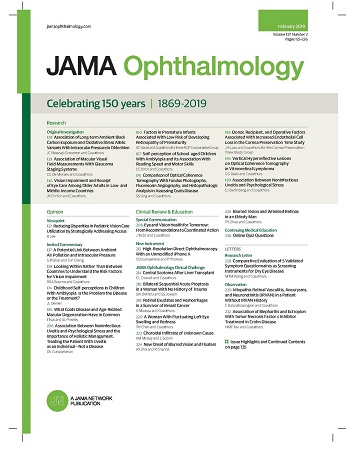Noninfectious Intraocular Inflammation After Intravitreal Aflibercept.
IF 7.8
1区 医学
Q1 OPHTHALMOLOGY
引用次数: 0
Abstract
Importance Aflibercept, 8 mg, is an anti-vascular endothelial growth factor (VEGF) formulation for neovascular age-related macular degeneration (nAMD) and diabetic macular edema (DME). While clinical trials report a comparable safety profile as aflibercept, 2 mg, clinical practice setting (so-called real-world) data on the incidence of intraocular inflammation (IOI) should be of value. Objective To determine the clinical practice setting incidence of IOI after intravitreal injection of aflibercept, 8 mg, for nAMD and DME. Design, Setting, and Participants This retrospective case series involved a review of medical records at a single tertiary care center. Participants were all patients who received an intravitreal injection of aflibercept, 8 mg, for nAMD or DME from March 2024 to October 2024. Patients had received injections with other VEGF inhibitors before. Standard care included slitlamp examination before each injection and follow-up examination within 4 days after every injection. Exposure IOI adverse events (AEs) after injections. Main Outcomes and Measures Incidence of IOI after intravitreal injection of aflibercept, 8 mg. Secondary outcomes included the time point of IOI and best-corrected visual acuity (BCVA) during and after recovery of IOI. Results Forty-one patients were treated with intravitreal aflibercept, 8 mg, injections: 23 with nAMD (56%) and 18 with DME (44%). Twenty-seven patients (66%) were male and 14 patients female (34%). A total of 136 intravitreal injections of aflibercept, 8 mg, were administered during the observation period. Five patients of 41 developed mild sterile IOI within 1 to 3 days after the intervention (incidence per injection, 3.7%; 95% CI, 1.6%-8.3%; incidence per patient, 12%; 95% CI, 5.3%-25.5%). Four patients had prior exposure to aflibercept, 8 mg, before the inflammation occurred; only 1 patient developed inflammation after the first dose. All patients were treated with local anti-inflammatory therapy (topical or subconjunctival corticosteroids), and 2 patients received additional systemic oral corticosteroids. No reduction of BCVA was observed after IOI-associated AEs receded. Conclusions and Relevance This analysis in a clinical practice setting revealed a more frequent occurrence of IOI-associated AEs compared with previous clinical trials. All observed cases showed a mild IOI, which resolved under anti-inflammatory therapy without loss of BCVA.非感染性眼内炎症。
afliberept, 8mg,是一种抗血管内皮生长因子(VEGF)制剂,用于治疗新生血管性年龄相关性黄斑变性(nAMD)和糖尿病性黄斑水肿(DME)。虽然临床试验报告的安全性与阿伯西普(2mg)相当,但关于眼内炎症(IOI)发生率的临床实践环境(所谓的现实世界)数据应该是有价值的。目的探讨玻璃体腔内注射阿布西贝8 mg用于nAMD和二甲醚后的IOI发生率。设计、环境和参与者本回顾性病例系列包括对单个三级保健中心的医疗记录的回顾。参与者均为2024年3月至2024年10月期间接受阿夫利西普(8mg)玻璃体内注射治疗nAMD或二甲醚的患者。患者之前接受过其他VEGF抑制剂的注射。标准护理包括每次注射前裂隙灯检查和每次注射后4天内随访检查。注射后的不良事件(ae)。玻璃体内注射阿布西贝8mg后IOI的发生率。次要结果包括眼内损伤时间点和眼内损伤恢复期间及恢复后的最佳矫正视力(BCVA)。结果41例患者玻璃体内注射阿布西贝8 mg,其中nAMD 23例(56%),二甲醚18例(44%)。男性27例(66%),女性14例(34%)。观察期间共给予阿布西普8 mg,共136次玻璃体内注射。41例患者中有5例在干预后1 ~ 3天内发生轻度无菌性IOI(单针发生率3.7%;95% ci, 1.6%-8.3%;每个病人的发病率,12%;95% ci, 5.3%-25.5%)。4例患者在炎症发生前曾暴露于阿布西普,8mg;首次给药后仅1例出现炎症。所有患者均接受局部抗炎治疗(局部或结膜下皮质类固醇),2例患者接受全身口服皮质类固醇治疗。在io相关ae消退后,未观察到BCVA的减少。结论和相关性:与之前的临床试验相比,在临床实践环境中的分析显示,与ioi相关的ae发生频率更高。所有观察到的病例均表现为轻度IOI,在抗炎治疗下消退,未丧失BCVA。
本文章由计算机程序翻译,如有差异,请以英文原文为准。
求助全文
约1分钟内获得全文
求助全文
来源期刊

JAMA ophthalmology
OPHTHALMOLOGY-
CiteScore
13.20
自引率
3.70%
发文量
340
期刊介绍:
JAMA Ophthalmology, with a rich history of continuous publication since 1869, stands as a distinguished international, peer-reviewed journal dedicated to ophthalmology and visual science. In 2019, the journal proudly commemorated 150 years of uninterrupted service to the field. As a member of the esteemed JAMA Network, a consortium renowned for its peer-reviewed general medical and specialty publications, JAMA Ophthalmology upholds the highest standards of excellence in disseminating cutting-edge research and insights. Join us in celebrating our legacy and advancing the frontiers of ophthalmology and visual science.
 求助内容:
求助内容: 应助结果提醒方式:
应助结果提醒方式:


